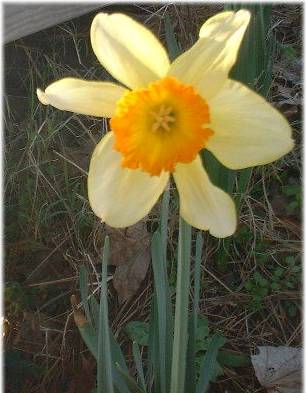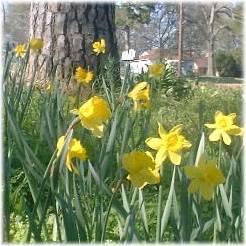|
Gardens Ablaze |
||
|
|
Daffodils
|
|
|
Detailed Bulb Profiles Site Map
Home |
At this writing, there are something like 13,000 Daffodil hybrids, but all share basically the same planting and care requirements. As with most bulbs, size of the bulb dictates how deep it is planted. Daffodils do not appreciate soggy feet, so locate them in an area that drains well. Plant about 2-3 times as deep as the bulb is long - pointy side up. Add a handful of compost or balanced fertilizer to the planting hole and water in well (be sure the fertilizer is low in nitrogen or you'll have all leaves and no flowers). Daffodils prefer full sun but will also do well in partial shade. They need about half a day of sunlight to do well. Remember, some of them are early spring flowerers that come into their peak before the leaves fill out in the trees, so they can be planted in areas that would normally be too shady for sun-loving plants. Wait until the air temperature goes below 56 degrees consistently before planting Daffodils, if possible, or the bulbs may rot before getting a chance to root. Also, try to give the earliest bloomers a somewhat sheltered area to protect them from the harshest winter elements.
Daffodils are prolific reproducers, and will eventually crowd themselves out if they are not divided. If you have noticed fewer flowers and crowded-looking stands, your daffodils likely need dividing. Wait until after flowering when the foliage starts to turn brown, but before it disappears. Dig the bulbs with a digging fork rather than a shovel to minimize the chances of destroying the bulbs, and then replant the bulbs appropriately in another area. I read a story in a magazine a while back in which a woman planted hundreds of Daffodil bulbs in a woodland area south of her house. She complained to the magazine (and they published a picture) of all the Daffodils facing south - away from her house. Not one Daffodil in that picture was facing her way. Daffodils do indeed point their faces to the south, so give this some thought if you are planning a large investment in Daffodils that may conceivably all turn their backs to you! Once you have that beautiful stand of Daffodils, don't forget to pick a few and place them in a vase of water with food coloring in the color of your choice. The flowers absorb the water and the edges of the petals turn the color of the water. This makes for a very pretty arrangement, and kids absolutely love trying out the different colors.
|
|
|
Gardens Ablaze |
||
 It
wouldn't be spring without Daffodils. If you are looking for the best
in all around cheerful color, easy care, reliability, durability, and even
deer resistance (they taste horrible and are poisonous), then Daffodils
are a sure bet for you.
It
wouldn't be spring without Daffodils. If you are looking for the best
in all around cheerful color, easy care, reliability, durability, and even
deer resistance (they taste horrible and are poisonous), then Daffodils
are a sure bet for you. Once
Daffodils stop flowering, the foliage must be kept on the plant until it
turns brown and dies. Leaving this foliage intact is very important
if you want an ever growing stand of Daffodils year after year. You
can hide the unsightly foliage with other plants such as Iris,
Once
Daffodils stop flowering, the foliage must be kept on the plant until it
turns brown and dies. Leaving this foliage intact is very important
if you want an ever growing stand of Daffodils year after year. You
can hide the unsightly foliage with other plants such as Iris,